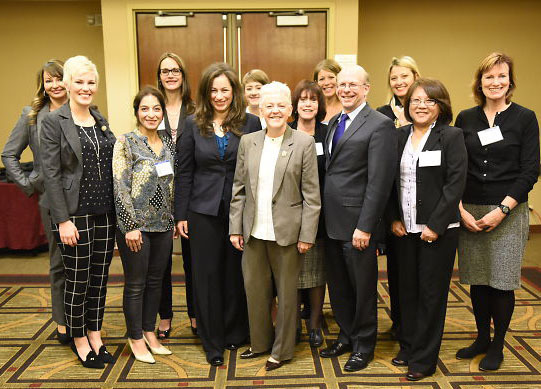
Elisa Cuan immigrated to the United States from Peru at the age of 16. After battling allergies for many years, she set out to learn more about the science behind air quality and allergens. She vowed to help prevent others from suffering the way she had.
Meanwhile, Mary Anne Auer, a registered nurse, saw first-hand that cleaning measures are essential to protecting medical staff and patients. She wanted to make sure that the products being used to keep people healthy weren't also causing damage.
Today, both women are CEOs. And they both run companies that carry products with EPA's Safer Choice label.
Last Friday, I sat down with Elisa from Joseli LLC, Mary Anne from Wexford Labs, Inc. and other women CEOs and senior managers from Earth Friendly Products, Grignard Company LLC, Case Medical, Sun Products, Jelmar LLC, Osprey Biotechnics, and State Industrial Products.

During Friday's discussion, I heard from many of this year's awardees about opportunities for innovation, barriers to progress, and ways that women-owned businesses can play a leading role in the shift toward safer products.
Safer Choice is about empowering parents and families to choose household products that use safer ingredients. Whether it's kitchen and bath cleaners, carpet cleaners, or laundry detergents -- when consumers see the Safer Choice label, they can feel good about the products being used around their kids, grandkids, and pets.
That's because Safer Choice products are backed by rigorous EPA science. Our experts use a stringent set of health and environmental safety standards to review products for the program. So when consumers see the label, they know it's a credible stamp they can trust.
After meeting Mary Anne and Elisa and other women leaders on Friday, it was crystal clear that these women aren't just health-conscious, they're also business-savvy.
They know that safer products aren't just healthier for people, and better for the environment, they're also profitable. They recognize that using safer chemicals creates competition. It promotes consumer choice. It brings newer, better products to market that people want to buy.
Innovation in safer products presents an incredible business opportunity, and the CEOs I met with on Friday are seizing it. They are some of the best and brightest minds in product innovation -- and they also happen to be fearless females.
At Wexford Labs, Mary Anne leads the development of disinfectants and antimicrobials that can keep people healthy and safe at the same time. Two of Wexford Labs products are Safer Choice certified.
At Joseli LLC, Elisa helped develop and introduce a dust-control product to the global marketplace that is Safer-Choice certified. All of the green technology solutions developed by her company are 100% biodegradable.
Elisa and Mary Anne are just two examples of a trend toward the use of products that are health- and Earth-friendly. Today, more than 2,000 products qualify to carry the Safer Choice label. And the list is growing.
Coincidence or not, many of those leading the way are women.
I've been in the business of protecting public health and the environment for more than three decades. Today, many more women have visible leadership roles in this arena -- whether it's in government, academia, or the private sector. But we have a long way to go.
Friday's conversation left me more optimistic than ever. And I can't wait to see what comes next.